Last year most diversified investors lost money regardless of what they invested in. This year will be all about individual stock selections. Volatility will remain elevated throughout the year and economic data will continue to dominate the investment news in the coming months.
Despite inflation figures falling slightly in major economies, longer-term structural issues such as an ageing demographic and a shrinking workforce will keep long-term inflation higher than we have experienced since the financial crisis of 2007/8.
Interest rate rises have started to slow in the US, with the Federal Reserve increasing rates by a smaller rise of 0.25%, while the ECB and Bank of England have implemented rises of 0.50%. This slower Fed rate rise has prompted an equity rally in the US, with bond yields also dropping as investors hope that a recession will be avoided.
At the moment stock market indices in general are moving upwards, but later on in the year individual stock picking will drive returns as company earnings are released. Those companies which exceed targets will be rewarded and those that miss… well, no one will want them in their portfolio anymore.
After last year, many asset classes now have a low baseline from which returns can grow. One area of interest for diversification could be infrastructure, which provides the opportunity for income and capital growth in a structurally changing world. Economics may continue to drive returns in the short-term, but longer-term returns will be driven by modernisation.
Areas of focus
• Commercial property returns are falling amid rising rates and a need for liquidity. Business default rates are likely to increase leading to void periods.
• UK equities have started the year strongly. The FTSE 100 may underperform other markets due to its strong performance last year. Small and mid-cap stocks are an uncomfortable place to invest but have the potential for good returns.
• Corporate bonds will make up a higher content of portfolios due to their equity-like and fixed-interest characteristics.
• Government bonds have performed well so far this year and but have considerable ground to make up.
• Infrastructure could be a good diversifier, providing both income and potential long-term capital gains amid an evolving clean and digital environment.
• Inflation-linked securities are preferred long-term as inflation is expected to remain at higher levels.
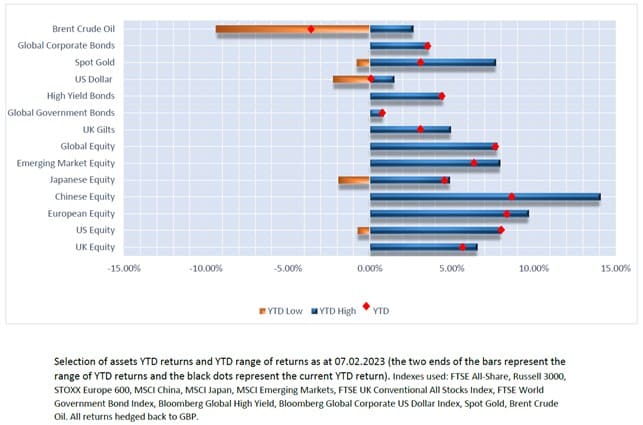
UK
UK consumer income is being stretched further still, but with the latest inflation readings showing a slight reduction in price growth, consumer confidence has picked up slightly. Consumers are still lacking confidence relative to the rest of Europe and the US. With the government energy support reducing in April this will increase pressure further.
Forecasts still point to contractions in growth, although these will be shallower than the 2008 financial crisis. The road ahead will still be shaped by how long and deep any recession lasts, which will in turn dictate how well company profits hold up and how much negative news markets have actually priced in. Current estimates suggest that markets have been too optimistic in recent weeks.
The Bank of England has again increased interest rates as expected, pushing rates up by 0.50% so that the base rate sits at 4%.
The view is that a more cautious approach is needed in light of the strong labour market, decreasing government energy support in April and potentially sticky inflation, making the decision on when to wind down interest rate rises a problematic one. Does the BoE continue with interest rate increases to make sure inflation comes down, while impacting negatively on economic growth? Alternatively, do they stop raising rates earlier but risk inflation getting stuck at a higher rate?
Market Movements
The FTSE indices have started the year in good form with all indices in positive territory. Last year the FTSE 100 provided positive returns for investors while the FTSE 250 and the FTSE AIM dropped by 17% and 33% respectively. So far this year the FTSE 100 has reached an all-time high, driven in large part by record oil company profits.
There is much debate over whether small and mid-cap companies will provide good investment returns this year. Much of last year’s falls priced in a recessionary environment, and with the latest forecasts from the IMF suggesting the UK will be the only major economy to have negative growth this year, investors’ preferences may lie elsewhere in 2023.
That said, if we see improvements in the UK economic landscape then the attractiveness of small and mid-size companies will increase. On the other hand, if markets have under appreciated the recessionary risk then we will see further falls in value.
Clearly there is a lot of ground for smaller companies to make up and we are seeing this reflected in the indices to some degree, with the FSTE 250 and FTSE AIM up 5.44% and 5.11% respectively YTD.
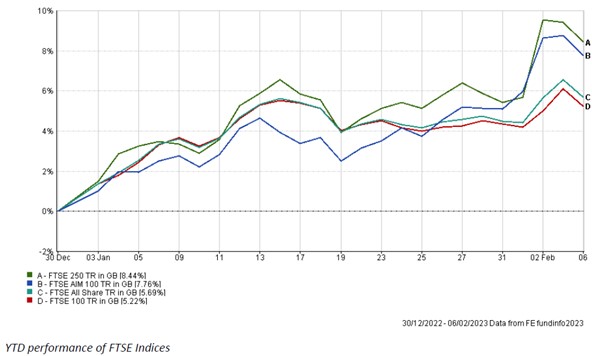
On the downside, the number of UK companies reporting profit warnings has picked up with a 50% increase recorded in 2022. If forecasts for economic data are correct, this trend will likely continue this year and will restrict share prices from climbing too high. The highest number of profit warnings came from the retail sector, followed by the travel and leisure sector; the most popular reasons for these warnings were increasing costs and missed sales targets.
Previous research into how those companies which have issued profit warnings have performed shows that many of these companies continue to struggle. Some are already restructuring, or have breached loan covenants.
The number of insolvencies last year – the highest since the financial crisis – highlights how much risk UK companies currently face.
While the desire for high equity performance this year is there (partly due to equity markets starting at year at a lower base value), there are lots of risks and our view is that volatility will remain elevated.
The UK will still be an attractive spot for dividends, although likely to revert closer to the global average. Normal dividends are expected to increase by 1.7% this year while special dividends are expected to decline by 2.8%.
Bond Yields
Longer-term gilt yields have dropped so far this year as investors bet on longer-term rates being lower and a UK recession being shallower than previously thought. We can see this when we look at the performance of the gilts above 1 year maturity since 1st January 2023:
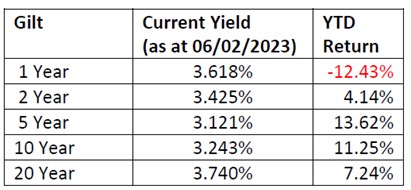
If the risk of a recession increases (or if the recession is deeper than expected) we will see yields rise further. The risk for UK gilts is that inflation sticks at higher levels and the BoE feels the need for more rate rises and/or for higher rates to continue for longer. This will push up yields further. Currently investors are guided by the BoE’s suggestion that rate rises will start to slow down next month.
A slight drop in inflation figures, and the expectation that this will continue, has reduced the yields of five and 10 year gilts the most. This is because longer-term bonds are affected by inflation to a greater degree. The 20-year gilts are widely held by pension schemes and the effects of interest rate changes on these bonds can be different.
US
After a disappointing 2022, US equities are off to a flying start in 2023, with the S&P 500 and Nasdaq 100 up by 4.70% and 10.34% respectively. This rally was largely fuelled by investor optimism that the US could witness a “soft-landing” scenario rather than a painful long-lasting recession.
In response to slowing CPI figures, investors are hopeful that the US Fed will start to ease its tightening of monetary policy or even begin to reverse it.
Other key factors that led to a sharp increase in US equity prices last month included a relatively weak US dollar, the reopening of the Chinese economy and several unexpected strong Q4 corporate earnings announcements.
Investors may be over-optimistic, however. Stock markets are hoping for an unlikely “Goldilocks” scenario: a robust US economy with no recession, plummeting inflation levels and interest cuts by the end of the year.
In our view this is unlikely to happen for multiple reasons. Firstly, a strong economy will lead to stickier inflation which significantly reduces the chance of a big Fed pivot on interest rates.
Secondly, China’s reopening (which is contributing to much of the recent growth in US equities) is likely to significantly increase global energy prices, pushing inflation levels higher.
Finally, it is likely that only a deep US recession could cause the Fed to abruptly change its course.
Despite the recent surge in US equities, investors are still flooding the Treasury website in search of low-risk fixed-income securities. Investors purchased $4.26 billion worth of these securities last month, leading to the best January on record, according to the US Treasury Department. After December’s cooler CPI figure of 6.5% was released, US treasury bonds rallied and pushed benchmark yields lower across the board in January.
This led to an increase in the price of the S&P500 US aggregate bond index by 2.88% over the month. However, in early February, an extremely positive January US jobs report raised the prospect of more interest rate hikes throughout the year – bond yields climbed and prices dropped back, accordingly.
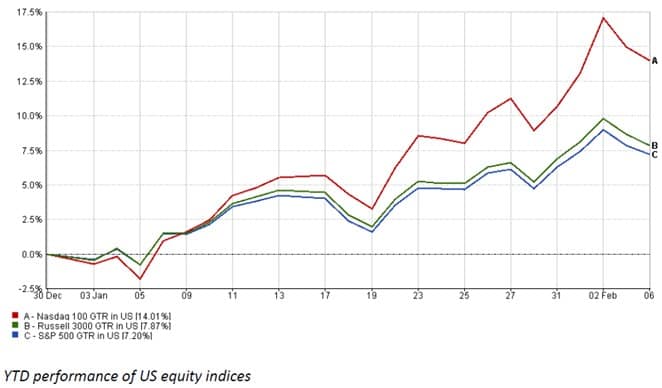
Europe
While the Eurozone overall is not expected to dip into a recession, the outlook for individual countries varies, with Germany’s economic health looking worse than that of France for example. We see this reflected in the stock markets’ performance YTD.
Despite having a volatile year (with many markets down 20% at one point), most have since recovered. The reasons for this? Investors are now looking for the silver lining in any economic data, even if they are ignoring the longer-term fundamentals.
Take Germany for example: since the start of last year, the German stock market index is up 2.8%. This is despite significant near-term headwinds in the form of missed earnings targets due to slowing trading growth and a still-present risk of energy supply issues.
Spain, which had a strong year relative to other European peers, is at risk of stalling this year as investors take profits and diversify into other areas. The Spanish stock market has a high weighting to financial companies, and even though banks may benefit from charging higher interest rates on loans, the number of loan defaults will also increase.
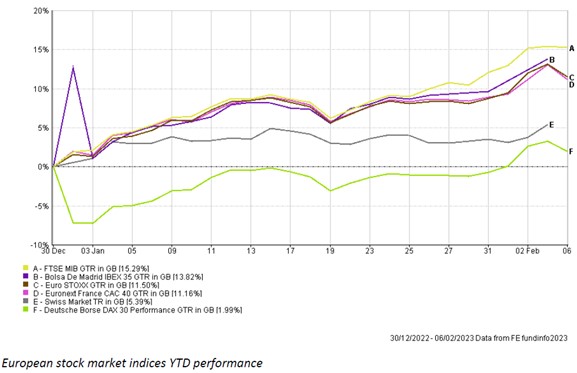
The ECB increased interest rates by 0.5% and bond yields across the bloc dropped, as the ECB signalled inflation remained too high despite recent falls. Another 0.50% interest rate rise is in place for March.
Headline inflation across the Eurozone dropped from 9.2% to 8.5% in December, but the core inflation reading (which strips out volatile sectors like energy and food prices) was unchanged at 5.2%.
In our view, markets this year will be driven by the ECB’s language around interest rates and the movements in this core inflation statistic.
Infrastructure
This month we discuss infrastructure as an alternative investment asset class which can offer diversification in a high inflationary environment. “Listed infrastructure” is the investment in infrastructure assets in the following broad groups: utilities, energy, transport, education, security and communications.
Listed infrastructure presents investors with an opportunity for both capital growth and income, with average yields in the IA Infrastructure sector currently at 3%.
One reason why infrastructure is preferred in high-inflation environments is because the contracts infrastructure companies have generally include inflation protection (in the same way as our phone contracts increase by a percentage above CPI or RPI each year, for example).
Infrastructure companies tend to be able to pass rising costs onto customers, giving them strong pricing power relative to companies like consumer retailers, where resistance to price rises can be much greater.
That said, like all asset classes, some sub-categories of infrastructure will perform better than others. With the industry performing relatively well in 2022, what is the outlook going forward?
The main tailwind for infrastructure is the theme of modernisation. Whether it is becoming more digital or decarbonising, a long-term change is underway and the need for new infrastructure assets to replace old assets is crucial.
We see this when we look at government spending policies. The US Inflation Reduction Act provides medium to long-term support for the infrastructure sector and with the EU now trying to follow suit, and the UK under pressure to do the same or risk falling behind, global support is certainly present.
For investors, this means increasing demand for infrastructure assets and in turn hopefully an increase in income and capital from the sector.
These positives must be balanced against a number of headwinds, however, that will provide challenges for the sector in future.
Companies can no longer rely on cheap credit. Rising interest rates are increasing the cost of capital for projects, which has the effect of either delaying projects or reducing their overall return. Companies that are looking to refinance will find this is a lot more expensive. The outcome will vary between managers, depending on the proportion of fixed-rate and floating-rate debt that is used.
As we have seen last year, geopolitical risks across the globe remain high, both in the Ukraine war and the US-China tensions.
The key opportunity in the nearer term for infrastructure remains the transition to clean energy. There have been lots of forecasts about how much the energy transition will cost, but generally these forecasts tend to be understated. This again presents further opportunities for investment.
While the US Inflation Reduction Act does provide support for this sector, the longer-term nature of construction and its tax credits means that any material gains will not be just around the corner.
In Europe, the Ukraine war has seen European countries scrambling to cut their reliance on Russian gas. Significant investment is required and aligning government policies provides a supportive backdrop for this.
Oil and gas infrastructure had a strong year in 2022, but now faces increased risks going forward due to increased supply, reduced demand and therefore a moderating price. Countries are looking to onshore or re-shore their transporting capabilities, to bring supply closer to home.
Communications infrastructure also looks to benefit from the roll-out of 5G and an increasingly digital economy.
All in all there are plenty of long-term opportunities in the infrastructure sector, but higher financing costs will bite into the bottom line.
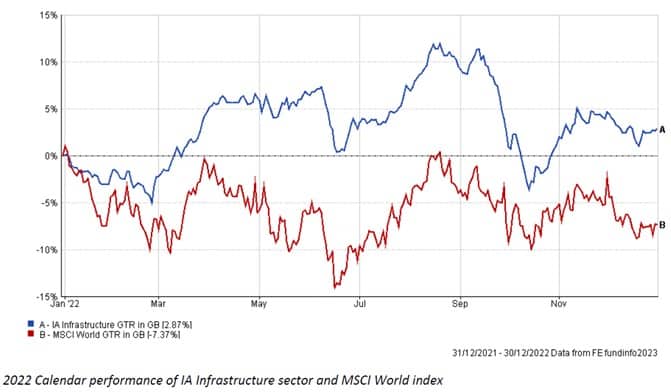
Robert Dougherty, Associate IFA
January 2023
This article is not a recommendation to invest and should not be construed as advice. The value of an investment can go down as well as up, and you may get less back than you invested.